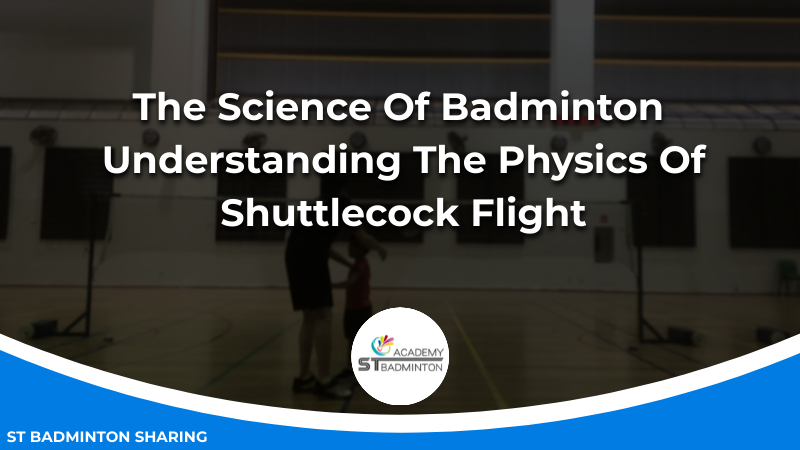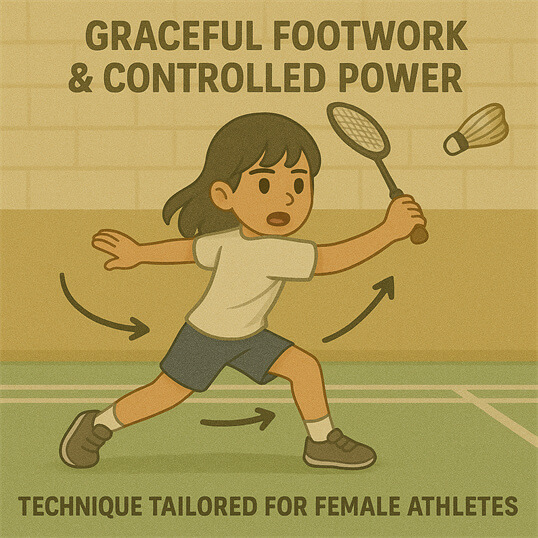Welcome to ST Badminton Academy’s badminton training in Malaysia! I’m passionate about understanding the physics of shuttlecock flight. From my experience with this amazing sport, I know that it’s more than just hitting a birdie over the net – there is an incredible amount of science behind each shot.
In this article, I’ll be exploring the fascinating world of badminton science by looking at how all the forces at work come together to create beautiful shots on the court.
No matter what level you play at or how long you’ve been playing, we can all appreciate the beauty of a perfectly-executed shot. By delving into the scientific side of things, we can gain deeper insights into why certain shots succeed while others fail.
It’s time to discover the hidden secrets beneath every single serve and rally!
The Forces Of Flight Malaysia
The forces of flight are the lifeline for shuttlecock movement. Like a bird in mid-air, badminton shuttles rely on two main physical forces to soar through the sky – drag and lift forces. These powerful elements guide the course of its journey but can be tricky to understand at times. It’s like trying to decipher the secret language between birds in their never-ending song!
We may not always observe it with our own eyes, but these invisible forces have an immense impact on how we play badminton.
Drag is generated by air molecules that cling onto the surface of a shuttle as it moves forward while the lift is created when air passes over its wings (feathers). Both types of force work together to create dynamic variation within each shot, making every single game unique!
As we enter into this realm of understanding, let us now explore the effect spin has on shuttlecock flight…
The Effect Of Spin
Let’s dive into the fascinating world of badminton science, and explore the theory and technique of spin!
It’s essential to understand the physics of shuttlecock flight, and developing spin techniques can give you a competitive edge.
Understanding Spin Theory
When it comes to serving techniques, spin is definitely key.
Generating topspin and backspin on the shuttlecock can be a tricky task for players of all levels – but with some practice, you’ll soon have those serves flying off your racket!
The materials used in the construction of your shuttlecock are also important when considering spin theory; heavier shuttles will generally generate more power behind each shot and make it easier to add extra rotation.
Ultimately, understanding how to vary your spins during gameplay can help you outplay even the most experienced opponent.
So get out there and start mastering that serve – don’t forget to experiment with different types of spin as you go!
Developing Spin Technique
Now that we’ve discussed the importance of spin and how it can affect your game, let’s look at some techniques you can use to develop a consistent spin.
The grip technique is key here – if you’re able to hold your racket properly in order to generate more power behind each shot, then adding extra rotation will come much easier. Other than choosing a good racket and also remember to choose the best racket restring in Malaysia.
It also pays to experiment with different string tensions too; looser strings may help increase accuracy while tighter ones could give you an edge when trying to create a spin on the shuttlecock.
All these factors combined make for a powerful combo so you can push your badminton skills up a notch! So remember – practice makes perfect when it comes to mastering those spins!
The Role Of Momentum
Spin plays an important role in shuttlecock flight, as it can influence the trajectory of a shot. However, understanding the physics of shuttlecock flight also requires an appreciation for momentum transfer and drag effects.
When hit with a racket, a shuttlecock is subject to both linear and angular momentum transfers from the racket head which cause the shuttlecock to accelerate forward. This type of acceleration produces lift due to Bernoulli’s principle – however, most of the pressure differential across the surface of the feathers dissipates quickly due to viscous drag effects on the air around them.
It’s at this point that spin becomes more influential in controlling the descent rate and direction of a shuttlecock; topspin imparts greater lift than backspin does because it creates higher airflow velocity over its upper hemisphere which results in lower static pressures there. Consequently, when combined with other factors like gravity and wind resistance, spin can have significant impacts on where a shot lands regardless of initial speed or height differences between shots.
The aerodynamics behind understanding badminton physics can provide insight into why certain strategies work better than others during games – specifically related to power generation while swinging and choosing appropriate angles for hitting shots depending on conditions like weather or court geometry. Understanding these details may be crucial for success!
Understanding The Aerodynamics
I’m so excited to dive into the science of badminton and explore the physics of shuttlecock flight!
Let’s start by talking about shuttlecock design and how it affects the aerodynamics at play.
We’ll then discuss drag forces, such as air resistance, and the lift forces that help the shuttlecock stay aloft.
Finally, we’ll look at how the design of the shuttlecock affects the trajectory of its flight.
Let’s get started!
Shuttlecock Design
Shuttlecocks are designed to be aerodynamic and fly straight, even with the air resistance from their feathers. This is achieved through careful material selection and strategic placement of the feathers.
The most important part of a shuttlecock’s design is its ability to create an optimal balance between two important forces: lift, which keeps it in midair, and drag (aerodynamic drag), which helps keep it flying smoothly over long distances.
To achieve this balance, manufacturers must carefully select materials that reduce drag while maintaining enough stability for flight. Feathers are often chosen due to their lightweight properties and natural ability to provide lift; however, synthetic fibers such as nylon or polyester can also be used when feather options aren’t available.
With careful consideration given to both material selection and feather arrangement on the shuttlecock head, badminton players can enjoy smooth play without worrying about the disruption caused by windy conditions or uneven surfaces.
Drag Forces
The drag forces at play, when a shuttlecock is in flight, are just as important to understand from an aerodynamic standpoint.
When there’s too much air resistance, it can cause the shuttlecock to lose lift and become more unpredictable.
On the other hand, if there isn’t enough air resistance, then it won’t be able to maintain its trajectory or stability.
As a badminton player, you need to find that perfect balance between lift forces and air resistance for maximum performance.
To achieve this balance, manufacturers must carefully select materials that reduce drag while maintaining enough stability for flight.
Feathers are often chosen due to their lightweight properties and natural ability to provide lift; however, synthetic fibers such as nylon or polyester can also be used when feather options aren’t available.
With careful consideration given to both material selection and feather arrangement on the shuttlecock head, players can enjoy smooth play without worrying about the disruption caused by windy conditions or uneven surfaces.
Lift Forces
Now that we understand the importance of air resistance, let’s talk about lift forces. Lift forces are another crucial factor to consider when understanding the aerodynamics of a shuttlecock in flight – it’s what keeps it going up!
These stability factors can be easily manipulated by adjusting the weight and shape of the shuttlecock head, as well as its feather arrangement. Too little lift force will cause the shuttlecock to drop too quickly; but if there’s too much air resistance, then you run into trouble with unpredictable trajectories and performance.
As badminton players, our goal is to find an optimal balance between air resistance and lift force for maximum performance. By analyzing these two key elements together, we can ensure smooth play even in windy conditions or on uneven surfaces – so don’t forget your trusty physics book!
Analyzing Shuttlecock Motion
In the world of badminton science, understanding shuttlecock motion is essential for optimizing performance. By analyzing flight patterns and trajectories of shuttles, we can gain valuable insights into how to enhance our game.
This includes selecting the right equipment such as racquets and shuttlecocks that will help us reach peak form quickly. The physics behind these motions is complex but fascinating.
For example, when a shuttlecock hits a racquet it experiences a certain amount of force depending on its angle, speed, and direction; each one affecting the trajectory of the birdie by varying degrees. With this knowledge, players can use their skillset more precisely in order to achieve maximum results during play – making a selection of appropriate playing gear even more important!
To sum up, if you want to be at your best while playing badminton then analyzing shuttlecock motion is key to success.
Frequently Asked Questions

What Type Of Equipment Is Needed To Play Badminton?
Playing badminton requires the right equipment – from racquets and strings to shuttlecocks. With proper maintenance, these items can last for years, ensuring you get the most out of your game.
When it comes to choosing a shuttlecock, consider its flight characteristics; heavier ones will drop faster than lighter models, so make sure you select one best suited to your level of play.
As a science writer passionate about badminton, I understand the importance of having quality equipment that meets our needs. After all, if we want to hone our skills on the court and enjoy lasting success in this sport, then taking care of our gear is essential!
How Long Does A Badminton Shuttlecock Typically Last?
The longevity of a badminton shuttlecock can vary significantly depending on its usage.
Generally, the more frequent and intense play it is subjected to, the shorter its lifespan will be.
The speed at which it travels and the flight patterns associated with shuttlecock trajectories are two important factors that influence how long a shuttlecock will last.
For example, if you hit your shuttlecocks too hard or too fast, they won’t last as long as those hit with less force and speed.
So, when playing badminton make sure you take into account these factors in order to get the most out of each one!
What Is The Difference Between A Feather And a Plastic Shuttlecock?
Feather and plastic shuttlecocks have distinct differences when it comes to badminton.
Feather shuttles are made from 16 goose feathers, so they’re much lighter than their plastic counterparts. This makes them more aerodynamic and easier for players to control – allowing them to adjust the spin dynamics of a shot with greater precision.
On the other hand, plastic shuttles last longer but don’t offer as much flight stability or accuracy due to their heavier weight.
So if you’re looking for a shuttle that will let you master the art of badminton, the Feather is definitely your best bet!
How Do Different Environments Affect The Flight Of A Shuttlecock?
Have you ever wondered how the environment can affect a shuttlecock’s flight?
It turns out that air pressure, temperature control, wind speed, and even shuttlecock weight all play an important role in determining its trajectory.
Badminton science writers often talk about the importance of understanding these factors when playing badminton – especially outdoors.
For example, if it is too cold outside then your plastic shuttlecock may not be able to reach its full potential due to increased drag resistance; while on warmer days the extra lift generated by rising air temperatures will help keep feather shuttles aloft for longer distances.
So next time you’re out on the court make sure to take into account all these environmental factors to ensure optimal performance!
What Is The Best Way To Practice For Badminton?
When it comes to perfecting your badminton game, practice is key! There are several important techniques and stances that you should master in order to improve your skill.
Make sure your feet are shoulder-width apart, with the right foot slightly ahead of the left. Also, be aware of string tension – a light string tension can help generate power while a tighter one can provide more control.
With these basics down, try focusing on shorter strokes rather than longer ones to maintain accuracy and speed during rallies. Finally, make sure to use different shots such as smashes or drop shots so you’re prepared for any situation when playing against an opponent.
By following these steps, you’ll undoubtedly become better at badminton and gain confidence in yourself as a player.
Buy Best Shuttlecock in Malaysia
Badminton is so much more than just a simple game – it’s an intricate science!
Understanding the physics behind shuttlecock flight can help players perfect their skills and improve their performance.
With practice, anyone can master this amazing sport and experience the exhilarating thrill of success that comes with mastering its complex mechanics.
Badminton may be challenging, but with enough determination and understanding of the science behind it, you too can become a badminton champion!





